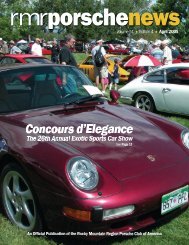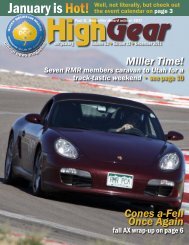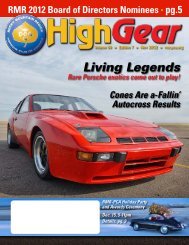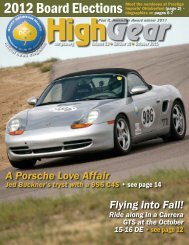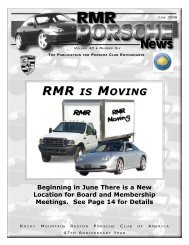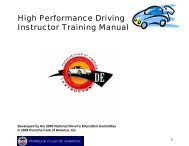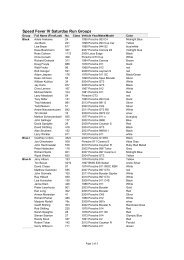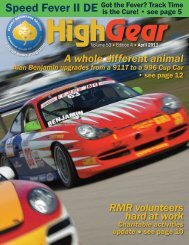Rocky Mountain Region Porsche Club - Porsche Club of America
Rocky Mountain Region Porsche Club - Porsche Club of America
Rocky Mountain Region Porsche Club - Porsche Club of America
Create successful ePaper yourself
Turn your PDF publications into a flip-book with our unique Google optimized e-Paper software.
instructors insight<br />
Driver's Ed. Education<br />
A Series <strong>of</strong> Specifics for Success<br />
by John Hajny<br />
Central NY <strong>Region</strong> Chief Instructor,<br />
Zone 1 Instructor<br />
Article #2 - The Language <strong>of</strong> Driving<br />
The main interface between Instructor and Student is<br />
Language. What should it sound like?<br />
Let's Talk Semantics<br />
Communication between a Driver's Ed. Instructor and<br />
the Student is obviously critical to the student's ultimate<br />
success. Verbal commands are generally the most effective<br />
means <strong>of</strong> signaling when a certain task needs to be<br />
undertaken, when there is a pending problem, or an adjustment<br />
to be made.<br />
In the early stages, information overload is a common<br />
problem for students, and experienced instructors will<br />
attempt to manage this flood <strong>of</strong> sensory input by using<br />
very simple terms to lead the student through the initial<br />
maze <strong>of</strong> confusion. Trying to elucidate complicated theories<br />
on car control dynamics is useless at this point, and<br />
both the student and instructor will be better served if the<br />
student feels a sense <strong>of</strong> calm and control emanating from<br />
the right-hand seat. Therefor, success is usually to be<br />
found by employing the K.I.S.S. Method: "Keep It Simple,<br />
Stupid!"<br />
If words are the best tools, what words to use? Hey,<br />
the dictionary is full <strong>of</strong> them, but if the student has to<br />
stop and think or ask what the instructor means, he or<br />
she may be distracted from doing something more important...<br />
like braking for a turn! One <strong>of</strong> the first steps toward<br />
Driver's Ed. success would then logically be to<br />
define and distill a list <strong>of</strong> terms to be applied consistently<br />
to the task at hand. This should be done before any driving<br />
takes place.<br />
O.K., after you position the car, the first thing you will<br />
have to do when preparing for a corner is to back <strong>of</strong>f the<br />
gas. For this purpose, we will use a word that is definitely<br />
a two edged sword, but as long as it is done before<br />
a turn - and not during it - the result should be<br />
favorable. That word is LIFT. (you likely will never hear<br />
your instructor say this in the middle <strong>of</strong> a turn!).<br />
The next task on the list is to reduce speed in a straight<br />
line. That function can obviously be described clearly and<br />
succinctly by using the word BRAKE. At this point it<br />
would be good to mention to the student that if you repeat<br />
any <strong>of</strong> these terms, it means you want more <strong>of</strong> that<br />
input right away, applied in a consistent, linear, but increasing<br />
fashion.<br />
Through experimentation and practice with braking, you<br />
will then reach a point where you have decelerated sufficiently<br />
to turn in safely. At this point, I use the term OFF<br />
BRAKE (or later, simply OFF) to signal the student that the<br />
brakes should be released smoothly in preparation for<br />
the anticipated steering motion.<br />
This steering motion is quite effectively described by<br />
using the word TURN. After turning in, I like to encourage<br />
my students to move back to the throttle as early as<br />
possible and begin applying it progressively after the turnin<br />
to help set their cornering arc and suspension balance.<br />
This is achieved by using the term THROTTLE. Later,<br />
when we are more experienced and accomplished in driving<br />
"the Line," we will combine these last two steps,<br />
but for now... yeh, you got it... K.I.S.S.!<br />
The next spot you will be heading for on the track is the<br />
epicenter <strong>of</strong> the turn's inside radius. This most critical<br />
point <strong>of</strong> reference that we are shooting for is the APEX.<br />
As we pass the apex, we are continuing to add throttle<br />
as we exit the turn. As our speed increases, it is time to<br />
UNWIND the wheel and head for the end <strong>of</strong> our arc. It<br />
is now time to use the full track width as we accelerate<br />
out <strong>of</strong> the turn and TRACK OUT.<br />
We now have our basic list <strong>of</strong> terms to get us through the<br />
cornering sequence with minimal confusion: LIFT - BRAKE<br />
- OFF BRAKE - THROTTLE - APEX - UNWIND - TRACK<br />
OUT.<br />
There are more terms that can be useful in certain situations.<br />
One such moment is when the instructor senses<br />
(likely before the student) that centrifugal force is causing<br />
the car to fight for grip. The tires are working harder<br />
than they should or could be, and if the situation is allowed<br />
to continue, an unsavory result is possible. The instructor<br />
should ask the student to UNWIND or RELEASE<br />
pressure on the steering wheel slightly and allow the car<br />
to become more balanced and flow more smoothly.<br />
Another situation that the instructor is likely to sense before<br />
the student (but you'll get there!) is when the car is<br />
traveling too fast or on the wrong line for a truly successful<br />
cornering experience. When this happens, the student<br />
must resist the temptation to modify any control<br />
inputs abruptly, and the instructor will ask the student to<br />
MODULATE or FEATHER the throttle, to HOLD the current<br />
settings, ride it out, and not make the situation<br />
worse by entering erroneous inputs.<br />
So, if we do it right, our distilled verbal cornering sequence<br />
will sound like this: LIFT <strong>of</strong>f the gas, BRAKE, OFF<br />
BRAKE, TURN, ease progressively into the THROTTLE,<br />
clip a tight APEX, UNWIND the wheel, and TRACK OUT.<br />
The use and understanding <strong>of</strong> a like sequence <strong>of</strong> terms<br />
will greatly assist your learning experience... and your instructors<br />
peace <strong>of</strong> mind!<br />
All portions <strong>of</strong> the<br />
PCA Zone 1 48 Hours <strong>of</strong> Watkins Glen handbook<br />
are Copyrighted © 1999-2003 by John Hajny<br />
I have striven to make this an extremely well written and accurate<br />
series on a subject that is not to be taken lightly and can<br />
obviously be dangerous. To maintain the accuracy and proper<br />
presentation <strong>of</strong> that message, I would ask that absolutely no<br />
use whatsoever <strong>of</strong> any text herein be made without my express<br />
written consent.<br />
I would ask you to please abide by this request. Thank you.<br />
<br />
16 October 2009 porsche



